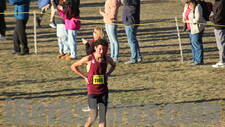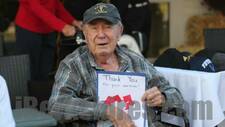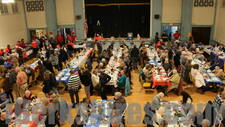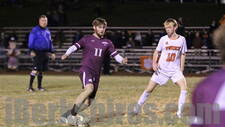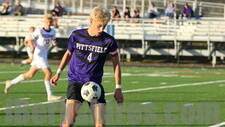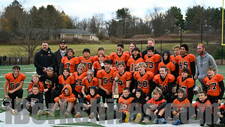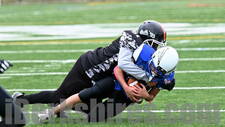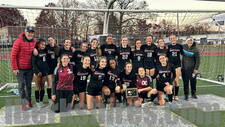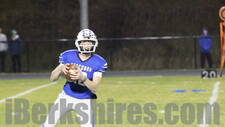Bytes from the Bean by Joe Manning 11-1-0012:00AM / Wednesday, November 01, 2000
Well, once again, I had a problem locating the subject of a photo I took (I also wrote about this subject in my April 2000 column). I took a picture of a tenement in February of 1999, but I forgot to write down what street it was on. In this case, I remembered that the house was off State Street, somewhere in the Hooker Street or Walnut Street area. So two weeks ago, I walked down State Street, up Walnut, across Furnace, down Francis, and down Hooker. I couldn’t find the house. I would have looked longer, but I had an appointment waiting.
Last Thursday morning, I tried again. I walked virtually the same route and then went further down State Street. Then I walked out to Noel Field and looked back from the top of the grandstand. Still no house. Then I walked back up Hooker and across Furnace and looked down, sometimes straying into people’s backyards. Still no house. I was baffled.
That afternoon, I was scanning photos at Keith Bona’s office, and I pulled out the “mystery photo,” which I plan to include in the new book. The following conversation took place:
Keith: "Hey, where’s that house? On Cliff Street?"
Joe: "No. It’s off State Street somewhere."
Keith: "Oh yea. I recognize it. You must have taken that picture a while ago. The city tore down that house last year."
Joe: "Great! I wish you had told me that two weeks ago. It would’ve saved me a lot of time."
^^^^^^^^^^^^^^^^^^^^^^^^
“I’m not getting old. I’m just getting older.”
-Julia White
On October 17, Julia White passed away at the age of 101. She has been mentioned often in this column. Julia was one of my best friends. She was the first person I interviewed for “Steeples.” That was on October 3, 1996. She was ninety-seven then and living at St. Joseph’s Court.
After she moved up the hill to Willowood on Franklin Street in April of 1998, I visited her frequently, usually once every three weeks. Despite her age and failing health, Julia was always sharp-witted and full of life. The last time I saw her was about a month ago in late September. When I arrived, she was sitting in a circle with a group of residents in the lounge, while a spirited and energetic employee was leading a discussion of recent newspaper headlines. One was about the big increase in successful businesswomen. I discreetly took a seat and listened.
Most of the participants were pretty quiet, but Julia was up to the task. After all, she was a very successful businesswoman many years ago. Whenever there was a lull in the discussion, the worker called on Julia, who never failed to disappoint. After the activity ended, the worker pointed to me and said to Julia, “You have a visitor.”
We didn’t talk for long. Julia was scheduled to go downstairs with the others for lunch, and I didn’t want to interfere. We exchanged our usual kiss and hug, and I waved as I walked away. She was smiling. That’s the way I’ll remember her.
^^^^^^^^^^^^^^^^^^^^^^^^
Many people ask me how I wound up visiting North Adams and writing a book about the city. I have revealed bits and pieces of the answer in some of my columns, but never the whole story. Fortunately, I have kept a diary of sorts. Beginning in this month’s column, by special request from some of my readers, I will include excerpts from that diary. The following is the first installment:
In January of 1996, the path that eventually led me to North Adams for the first time began oddly enough in New Jersey, where I was visiting my daughter Sarah, the sax player. She was a sophomore in the Jazz Performance program at William Paterson College. While she took a shower and fussed with her hair (I think we were going out to eat), I sat in her dorm room and read an article in a jazz magazine about the financial difficulties suffered by musicians trying to make a career in the jazz world. There was a story about Hank Mobley, the great tenor sax player who worked with Miles Davis and John Coltrane, and was a recording star for Blue Note Records in the fifties and sixties. According to the article, Hank died penniless and homeless in a train station in Philadelphia, where he was seeking shelter. I looked at Sarah and burst into tears. I thought, “Will this be her fate?”
A week later, still haunted by this, I sat down and wrote a poem called "Gig At The Amtrak," imagining I was Hank living in the train station and playing for handouts. I hadn’t written a poem in years, but it poured out of me in less than an hour, and I felt a sense of relief. I showed it to my other daughter Ellen, the poet, an English major at the University of Connecticut branch in Torrington, where my wife Carole and I lived. Ellen liked my poem and recommended that I write more. She suggested that I attend a meeting of the First Wednesday Poetry Group in Washington, Connecticut.
On May, 1, 1996, I attended my first meeting of the First Wednesday Poetry Group with Ellen. I read "Gig At The Amtrak" and got a lot of compliments. I went home resolving to write more poems. A month later, Sarah was accepted to Smith College in Northampton, Massachusetts, where she had applied for a transfer. On several visits to the college, Carole and I had traveled some of the back roads through the hill towns of the Berkshires. We liked what we saw and started exploring the area on weekends.
In early July, I attended my second First Wednesday meeting. I had no poems to read. I was having trouble coming up with ideas. The following week, Carole read me an article in the our local newspaper about a contemporary art museum that was locating in some abandoned factory buildings in North Adams, Massachusetts. It was called MASS MoCA. “An interesting idea,” I said to Carole, “Let’s go check it out.”
Despite living in Connecticut for twenty-five years and traveling many times up Route 7 to Vermont, it had never occurred to us to go to North Adams. I remember pulling off on Route 2 several times to look at Williams College in Williamstown and turning around at the Howard Johnson’s, somehow unaware of North Adams just three miles farther.
On Sunday, July 21, we drove two hours up Route 8, stopped at the Miss Adams Diner in Adams for a late breakfast, and descended into downtown North Adams from the Hadley Overpass. We looked in amazement at the church steeples and the tall brick and stone buildings on the north side of Main Street and wondered why there was almost nothing on the south side. I remember turning to Carole and saying, “Let’s walk. I’ve got to see more of this.”
Across the street was a restaurant called the Appalachian Bean Café, but it was closed. We were disappointed, because it was attractive and inviting. We wandered slowly for nearly three hours, making wider and wider circles around the city. We marveled not only at the strange and haunting beauty, but also at the odd lack of anyone on the streets. We finally made our way to Marshall Street, only to learn that MASS MoCA was closed. All we saw was a bunch of huge brick factory buildings with broken windows. There was a poster on the office door announcing a photographic exhibit by rock musician David Byrne the following weekend.
When we got home, we booked a motel in Williamstown and drove up that Saturday. When we got to MASS MoCA, we learned that David Byrne had been there to conduct a personal tour, but that he had just left to go home. The exhibition was intriguing, although the gallery space was an empty factory building, scruffy and dimly lit. Along with Byrne’s photographs, there was a big long table covered with architectural models of famous urban buildings surrounded by an electric train, which ran continuously around and around. I talked briefly with Bill Sweet, the artist, while he fooled with the train and fielded questions from visitors. We took a chance and signed on as MASS MoCA members for $35, although we were told that the completion date was not expected to be any sooner than the summer of 1998.
Later in the afternoon, we walked into Milltown Studios, an art gallery and café on Main Street. We met Terry Girard and Jeffrey Briggs, who had just opened it. They gave me their newsletter, which had a list of concerts and poetry readings coming up. We also met Chuck Wilson at the Gateway Clothing Store on Main Street, and I asked him a lot of questions. He told me that the Sprague Electric Company, the former occupant of MASS MoCA, had moved out in 1986, and that it had employed more than 4000 people at one time. He also explained that most of the buildings on the other side of the street had been torn down in the late sixties as part of an urban renewal project.
Friendly and soft-spoken, Chuck reminded me of a character in a Norman Rockwell painting. With MASS MoCA on the horizon, he showed considerable hope and enthusiasm for the future of the city. The Appalachian Bean Café next door was closed again, but we made a note that it opened on Sunday morning at eight..
We got up early on Sunday and headed to the Appalachian Bean. We got bagels and coffee and sat at a counter, which looked out the front window facing Main Street. It was a nice view. An old man with a beagle on a leash walked by. The man was wearing a hunter’s cap and a plaid shirt. Both the man and the dog looked weary. I turned to Carole and said, “I think I’ll write a poem about this,” and jotted down a few notes. We hung around all day, drove up to the summit of Mount Greylock, and ate dinner at Boston Seafood in North Adams.
As we headed out of town on Route 8 about seven-thirty, we heard a train coming. We abruptly turned around, parked at Heritage State Park, and ran up to the top of the footbridge over the railroad tracks. A young man and an older woman were there, and the man was jumping up and down and screaming in delight. The train came through the Little Tunnel, rumbled under us, and headed south. To our surprise, there was another shorter train that was pulled off to the side waiting to go through from the other direction. It did after a few minutes, and we were treated to another show.
On Wednesday, August 7, I finished my poem about the old man and his dog and read it at the First Wednesday meeting. I called it "Two Flights Up," because I imagined that the man lived above one of the storefronts. Someone suggested that I write more poems about North Adams, so I decided to take a day off from work and drive up by myself to see what I could come up with.
A week later, I got up before dawn and made the two-hour drive on Route 8, arriving in North Adams at seven. It was a gorgeous day. I brought my camera, a pen, and a pocket notepad. After a bagel and coffee at the Appalachian Bean Café (called The Bean I found out), I sat on a bench in front of the library and just watched for a while. City workers were re-paving Main Street. The noise and the smell of tar was annoying, so I started out on a long walk that lasted all morning. I found myself taking lots of photos. My journey took me across the railroad tracks behind the American Legion. I stared south at the mountains and headed down the tracks. I must have traveled about half a mile before I got tired and turned around. I wrote down what I saw, and the notes became part of a poem called "Seven Steeples," which I wrote at The Bean later in the day.
I remember passing what I thought was a Catholic school on Eagle Street and asking a stranger about it. He told me it that it used to be St. Joseph’s Catholic School, but was now an elderly housing complex called St. Joseph’s Court. I was charmed by the notion of living in a school. I crossed the street, sat on the St. Francis Rectory steps, and imagined I was a widow living out my last days at St. Joe's. I tried out a few lines of poetry, speaking as if I were her.
On the way back to The Bean for lunch, I turned the corner at Eagle and Main and noticed a line of old men watching the street getting paved. There must have been fifty of them, and they were standing virtually motionless, some in groups and others alone. This scene became the subject of another poem called "Old-Timers."
I had told Carole that I would be home by dinner, but around three o’clock, I found a pay phone near the Big Y supermarket, called home, and left a message. “Everything is fine. I am having so much fun, that I am going to stay for dinner. I’ll call later.” For the first of what would become hundreds of times, I was disappearing into North Adams.
To be continued in December
Visit Joe's website at: www.sevensteeples.com.
Email Joe at: manningfamily@rcn.com
|


